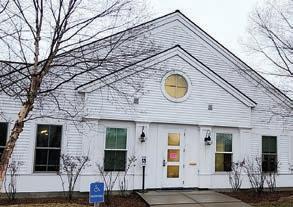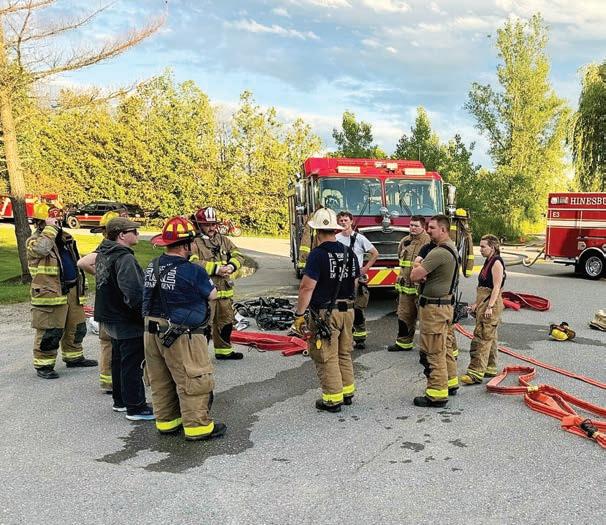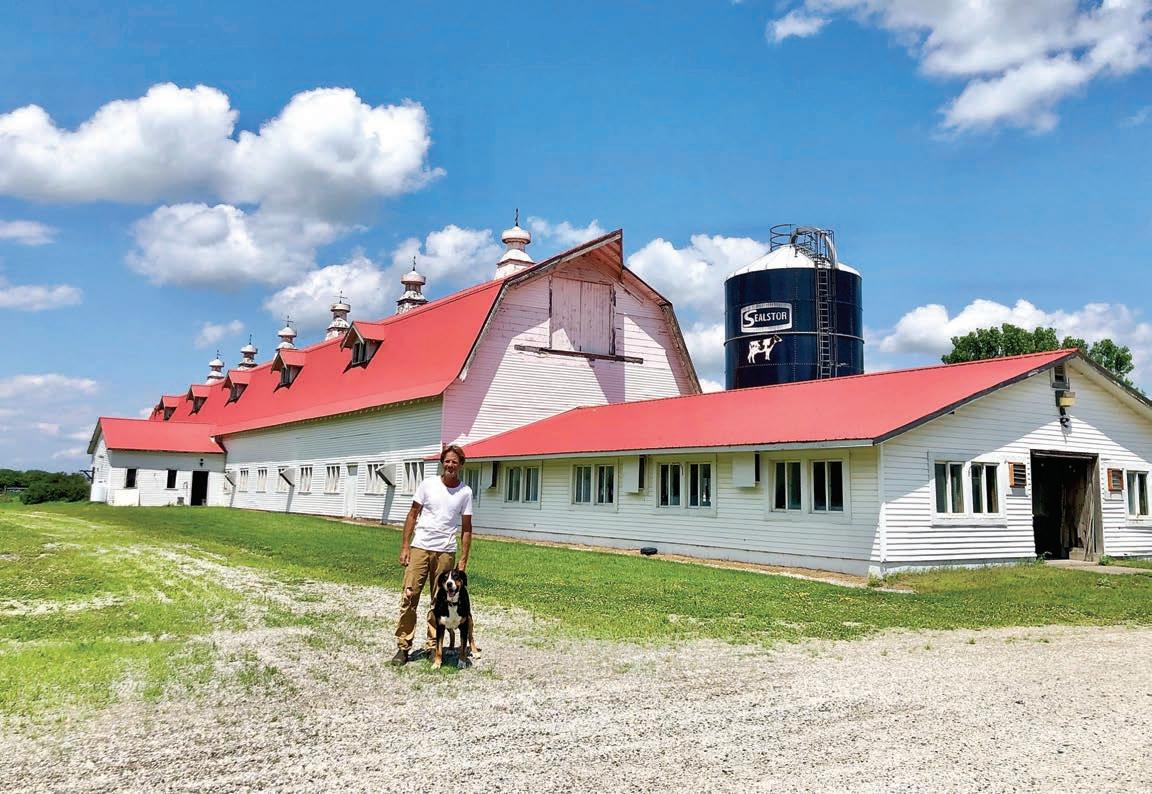






Way out on a hill off Route 7 sits a sprawling property iconically marked by red-roofed barns that strikingly contrast with the Green Mountain landscape around them.
Inching closer to Charlotte, the noise of a bustling city begins to fade as chirps from

the insects, crickets, and other wildlife fill the air. Those barns are more commonly known as Nordic Farm, a standing testament to what was once a booming dairy industry in Vermont.
Now, as two new owners close on the latest sale of the property, there is no extravagant plan in the works — not quite yet. Instead, the New York natives plan to do something much more grandiose: “Keep it simple.”
Benjamin Dobson and Kaspar Meier, a prominent farmer and a builder from Columbia County in New York, closed on the sale of the conserved property of just under 600 acres on July 2 after more than a year on the market without any serious interest.
But according to Meier, the duo has taken up the challenge, “hook, line, and
sinker.” They bought the property for $2.2 million, significantly less than the grand list value of $3.2 million.
A long history
The property has seen a frequent shift in ownership and ideas over the last decade,
See NORDIC FARM on page 8

LIBERTY DARR STAFF WRITER
The Charlotte Selectboard wants to slow down speeders on Ferry Road.
The board is looking for a solution to a speeding problem on a stretch of Ferry Road between Greenbush Road and the railroad tracks, mostly utilized by those looking to catch the ferry to New York.
Two years ago, the speeding issue peaked when a group of three dozen residents along Greenbush Road filed a petition that implored “the selectboard to act to enforce the traffic laws on our street in response to ongoing community concern about the challenges dangerous drivers pose to safe automotive, pedestrian and bicycle travel within our neighborhood.”
It’s not uncommon for residents in that expansive area of town to see cars traveling up to 70 mph. For Carla von Trapp, waking up at 4 a.m. to the sounds of zooming cars is an everyday reality for her and her neighbors.
“I often see 50, 70 (miles per hour),” she said at a meeting last week. “We have someone that goes by about that speed every night at 4 a.m. and wakes up quite a few people on the street.”
According to a traffic study conducted by Chittenden County Regional Planning, the nature of that section of road for those traveling west from Greenbush Road may add to the problem.
The east side of the Greenbush intersection features a village setting with post office, library and senior center, which typically signals drivers to slow down.
But with lesser-density residential development and long driveways on the west side of the intersection, nearly 85 percent of drivers over a given week travel at speeds around 10 miles over the
designated 40 miles per hour on that stretch of road.
“Motorists traveling westbound exiting the west village area tend to drive at higher speeds due to the open landscape, and straight road section with a steep downgrade. This presents safety concerns for all road users including pedestrians and bicyclists and speed enforcement becomes a challenge within this study area,” planners wrote.
Charlotte is not alone in dealing with speeders. Other surrounding areas, like Shelburne, have also taken substantive measures to reduce traffic speeds in the hopes that the town may be a safer place to walk and bike.
Shelburne not only has an official bike and pedestrian committee but two other resident-led groups that have been focusing, for many years, on traffic studies, traffic calming solutions and how to implement safer infrastructure for those not using a vehicle.
But Charlotte’s problems are unique in that the town has no enforcement capability for its speed limits. The town is without a police force and instead contracts with the Chittenden County Sheriff’s Department to patrol the town for only eight to nine hours a week on weekdays.
“I’m going to tell you — maybe a lot of people in here might not like it — but you can put up as many signs as you want. It’s not going to slow the people down,” road commissioner Junior Lewis said. “Guess what’s going to slow him down? You get a ticket, you get a ticket, you get a ticket, I get a ticket. No warnings. Then people will start slowing down when they see an officer. When was the last time you saw an officer pick up somebody there?”
In his mind, the town can put up as many signs as they want, but it’s not going to satisfy residents’ desired outcome.


For some residents, this is exactly the reason that some traffic calming measures should be implemented.
“Police enforcement is unlikely or minimal, but I would like to see some of the other measures as recommended: rumble strips, crosswalks, signage on the pavement, narrowing the roadways, making it clear that a pedestrian or a bicycle has access to the full roadway. I feel like there’s a lot of signage that can be done, and other measures need to be taken,” Maura Wygmans said.
The study offered a few solutions like lowering the speed limit, widening the existing fog lines from 4 to 6 inches along the edge of the pavement, and installing rumble strips and median islands.
The board Monday night



approved adding more sings along the road but held off on approving anything else until they decide on a reduced speed limit. The study recommended lowering speeds by 5 miles per hour, but board member Lewis Mudge questioned why the board couldn’t consider an even lower limit, like 25 mph.
“If we only have one bite at this apple, and it’s taken a year to get here, why wouldn’t we lower this to 25 because we can anticipate there’s going to be a lot more foot traffic on this,” he said, noting the work to a major trail being completed in the surrounding area.
While the board is expected to take up lowering the speed limit and the other recommended measures at a meeting in two weeks, there was concern about how to fund these measures.
After concerns were raised on Greenbush Road in 2023, the board attempted to budget nearly $25,000 for traffic calming measures. But when that budget was voted down on town meeting day, the board scaled back its spending plan.
The board opted to add no traffic calming money again this budget year.
“We also have to discuss where that we have to know at that meeting what budget this is coming out of,” board member Kelly Devine said. “I don’t think it’s fair to put it on the road commissioner. As you know, our budgets have been extremely tight, and we had one that failed. We have some significant cost increases we’re facing in the current year, so it’ll be a challenge to try to find that.”


One hundred and fifty Vermont cities and towns have adopted the Vermont Declaration of Inclusion to ensure all residents, visitors and people considering moving to their community feel welcome, safe and that they belong.
Municipalities that adopted the declaration include South Burlington, Shelburne and Hinesburg.
This milestone follows a busy month in May when Gov. Phil Scott pronounced the second week of May “Inclusion Week,” his fourth such proclamation. “The State must and will continue to address the challenges of achieving racial and ethnic equity across Vermont and to nurture the diverse society in which we want our youth to live and prosper,” Scott said.
On May 9, the declaration of inclusion was recognized at a press conference at the Capitol. The grassroots initiative begun by community members in the Rutland area has built up momentum with the help of Vermont Interfaith Action, Vermont Chamber of Commerce, Vermont League of Cities and Towns and the Vermont Council on Rural Development.
At the press conference, Rep. Kevin “Coach” Christie, D-White River Junction,
and a member of the NAACP, wondered if Vermont considers itself a welcoming state, why do people leave the state?
“It’s important for our state to grow and ensure that when people come, they want to stay and can stay,” Christie said in a press release.
Willie Docto, an innkeeper in Duxbury and chair of the Vermont Chamber of Commerce’s diversity, equity, and inclusion task force, pointed out that the mission of the chamber is to advance the Vermont economy and that the declaration is essential in achieving that goal.
“I hope that news of what’s happening here, spreads far and wide. People beyond Vermont know that there are communities across our state that are eager to welcome them,” Docto said.
The Vermont Declaration of Inclusion Initiative will continue to reach out to all municipalities in the state. A second phase of that work is underway to assist those municipalities that have already adopted the declaration to implement it.
“Adoption is just the first step,” founder of the initiative, Bob Harnish, said. “We then ask our towns to bring it to their residents so true inclusion becomes a work in progress.”
For many Vermonters and out-of-state visitors, summer means camping, hiking and taking part in other outdoor recreational fun. However, these activities can all spread invasive plants, insects and diseases, unless steps are taken to minimize damage to the environment.
University of Vermont Extension, Vermont Department of Forests, Parks and Recreation and the Vermont Agency of Agriculture, Food and Markets have teamed up to inform and educate outdoor recreationists about what they can do to prevent the introduction of or spread of these pests through their new Arrive Clean, Leave Clean campaign.
The purpose of this outreach, launched in June, is to encourage anyone who spends time outdoors to follow three steps when leaving the woods. These are to clean their gear, check their vehicles for egg masses or other life stages of spotted lanternfly and not to move firewood.
According to Ginger Nickerson, UVM Extension forest pest education coordinator, “Although the spotted lanternfly has not been reported in Vermont, it has been confirmed in neighboring states, including New York and Massachusetts. All life stages of this invasive pest can hitchhike long distances on vehicles and infest new locations, thus the need to be vigilant.”
The same is true for other invasive species not yet detected in Vermont as following the same three steps will help prevent their spread. These species include oak wilt, a fungal disease that has killed millions of
oak trees nationwide; the Asian longhorned beetle, which attacks maple trees; and the hemlock woolly adelgid, which will decimate entire stands of hemlock, leading to loss of deer habitat and cooling of streams for trout.
“Invasive plants, insects and pathogens can be spread unknowingly by people, changing the forest landscape as we know it,” Nickerson said. Although we can’t do anything about the spread of invasive species by birds, animals and wind, many pathways are under human control, including through outdoor recreation.”
Because invasive plant seeds and insects can lodge in dirt in boot or bike treads, or hide in the folds of clothes or gear, it’s important to clean all gear before and after heading outdoors to avoid dispersing insects or their eggs to new areas.
Consider keeping a brush in your vehicle to brush off boots, clothing, bicycles and gear, especially any gear that has been stored outdoors, before heading out on a trip, and when returning from the forest.
If you have traveled to a state where spotted lanternfly is established, Nickerson recommended inspecting your vehicle before returning to Vermont. The adults especially like to lay eggs on rusty metal, so carefully examine wheel wells and other areas on vehicles. The egg masses look like patches of dried mud and are not easy to detect.
One of the most common ways inva-
See CAMPAIGN on page 11
The butterfly in our front-page photo last week is actually a red admiral butterfly, not a swallowtail.

champlainvalleyfair.org







Serving the community of Charlotte & Hinesburg A publication of Vermont Community Newspaper Group LLC thecitizenvt.com
Advertising Wendy Ewing wendy@shelburnenews.com (802) 985-3091 x12
Advertising Director Judy Kearns judy@otherpapersbvt.com (802) 864-6670 x21
News Editor Tommy Gardner
Staff Writers
Aaron Calvin Liberty Darr
Production Manager
Stephanie Manning stephanie@shelburnenews.com
Editor/Publisher Gregory Popa gpopa@stowereporter.com
Billing inquiries Leslie Lafountain leslie@stowereporter.com (802) 253-2101
Advertising submission deadline: Friday at 5 p.m. advertising@thecitizenvt.com classifieds@thecitizenvt.com
Editorial submission deadline: Friday at 5 p.m. news@thecitizenvt.com
Calendar submission deadline: Friday at 12 p.m. news@thecitizenvt.com
Contact: 1340 Williston Road South Burlington, VT 05403 (802) 985-3091




Guest Perspective
Michael Caldwell
Three days before Independence Day, the U.S. Supreme Court handed down its historic and democracy-shattering ruling that U.S. presidents have almost absolute immunity to criminal prosecution. Former President Donald Trump will now likely not be held accountable for trying to subvert the duly certified 2020 presidential election.
America, welcome back to the political doctrine of the divine right of kings.
Two years shy of the 250th anniversary of our republic, we revert to the tyrannical tradition of King George III. For thinking people here and now — Republican, Democrat, Independent — it was a painfully ironic moment, coming as it did so close to July 4.
Isn’t Independence Day the day we declared independence from monarchy? Isn’t part of the celebration remembering the sacrifices our founders made for freedom from unfettered monarchical rule? Why would we go so far astray with some kind of “originalist” justification for the ostensible revision of our beloved U.S. Constitution? How can we read the Preamble and not weep? “Secure the blessings of liberty”?
What the Trump-infested court has done is to make liberty completely insecure. The stacked deck of his three appointments means “we the people” are now potentially subject to the vile wiles of a bigoted bully who can do anything he wants, if he gets re-elected, with almost no legal guard rails.
Implied immunity, of course, is immunity to deceptive practices. Presidents can now lie and deceive to their heart’s content, confusing and confounding the electorate with no real redress for new grievances and injuries.
Deception already plagues us. Conspiracy theories infect social media like a new pandemic with no vaccination or immunity. Our new idol, worshipped for its addictive charisma, is social media. Kids can’t take their eyes off a screen. Kids and adults now are force-fed fodder for far-fetched feudalism, with calculated agendas against the commonwealth. You’ll find the new feudalism alive and well on social media, often disguised as salvation.
The right claims that the left is responsible, with gay rights and
abortion rights, for example, for decline and decadence of America. Can we take a breath? Can the right look at its hypocrisy for promoting autocratic Christian nationalism in a nation of immigrants? The decline of the republic is much more to be feared if we don’t take a warning from the 1930s.
Decluttering my office, I almost recycled a pamphlet of Harry Emerson Fosdick, founding minister of Riverside Church in New York, in which he nudges us to shed our isolationism in the face of German “Christian” nationalism and Nazi authoritarianism.
Fosdick wrote that in “Mein Kampf,” Adolph Hitler says this: “By means of shrewd lies, unremittingly repeated, it is possible to make people believe that heaven is hell and hell, heaven. The greater the lie, the more readily it will be believed.”
Trump takes this page from Hitler and makes it the backbone of his playbook. We all saw that in his repetition of despicable lies about the 2020 election and about Biden on the June 27 debate stage. Biden’s completely imperfect, as we saw in that debate; he is also the clear alternative to the startling willful deception of his opponent
and the whole MAGA nightmare.
Can Trump and his fearful followers win? Only if thinking people give in to deception and give up. The hope of John Hancock, Benjamin Franklin, Thomas Jefferson and the rest of the signers of the 1776 Declaration will be dashed.
The other sad irony is that the right refers to these founders as creating a Christian America that
we must recover. Nothing could be further from the truth. Yes, there were Presbyterians from New Jersey and Catholics from Maryland, but most of the signers were Quakers or Deists (like today’s Unitarians) who reverenced the Almighty as a God of justice, diversity and liberty, not deception, theocracy and monarchy.
Who will we honor this, Inde-
pendence Day? Honor the signers, or honor King George?
We’ll decide, with a clear and compelling choice, on Nov. 5.
Michael Caldwell is a member of the international ecumenical Iona Community. The Radical Center is a syndicated monthly column transcending current fractures in culture and religion. He lives in North Wolcott.
Move toward a union will cost taxpayers, now and in the future
Guest Perspective
Tanna Kelton
There’s been very little community engagement about the majority of Charlotte’s 10 eligible municipal employees organizing to become unionized. This is not a small issue for the taxpayer, and it will be very costly in terms of our property taxes going up to cover union-negotiated salaries and benefits.
Because of any potential
future binding contractual obligations between the selectboard and the union, the taxpayer will have no choice but to pay for these negotiated salaries and benefits, and we will either have to cut services in other areas, such as fire and rescue and road maintenance, or face continual property tax increases.
The binding contractual obligations will become the priority in the town budget, with all other budgets becoming less of a priority or being cut. Under these
obligations, the only winners will be the employees. This will affect upcoming generations. Many town employees don’t live in this town, so it’s likely they’re not worried about how this move to unionize will long affect the people of Charlotte.
Just a couple of years ago, the town employees were given very generous pay raises. Currently, most town employees contribute
See KELTON on page 9


Oliver King is the recipient of a new Responsible Growth Hinesburg scholarship intended to support students who value environmental stewardship and community service. “This scholarship will be used to fund my education at a folk school in Norway this school year, which will give me an opportunity to work and thrive in a small tight knit community,” King said. “Growing up in Hinesburg has given me an incredible appreciation of the importance of small communities and I hope to use this education to continue to be a part of such communities, whether in Hinesburg or elsewhere. Looking to the future, I am hoping to pursue a career in building and sailing traditional wooden boats, which encompasses another amazing, small community that I have grown to be a part of over the past several years.”
The Age Well meal pickup for Wednesday, July 17, is from 10 to 11 a.m. at the Charlotte Senior Center. The meal features chopped beef steak with mushroom gravy, mashed potatoes, broccoli, wheat roll, pumpkin cookie, and milk.
You must pre-register by the prior Monday at 802-425-6345 or meals@charlotteseniorcentervt. org. The suggested donation is $5. Check the website for last-minute cancellations at bit.ly/3FfyLMb.
The meal on Wednesday, July 24, features breaded chicken with gravy, mashed cauliflower, Brussel sprouts, white dinner roll, tapioca pudding with peaches and milk.
The meal on Wednesday, July 31, features meatballs with marinara sauce over penne pasta, mixed vegetables with lima beans, wheat bread, pineapples, oranges, and milk.
Age Well is offering a luncheon on Tuesday, July 16, in the St Catherine of Siena Parish Hall, 72 Church St. in Shelburne.
The menu is egg salad with

celery and onions, coleslaw, spinach salad with chickpeas and veggies, Italian dressing, dinner roll, Congo bar, pears and milk.
You must register by Wednesday, July 10 to Kerry Batres, nutrition coordinator, 802-662-5283 or email kbatres@agewellvt.org.
Tickets are also available at the Age Well Office, 875 Roosevelt Highway, Suite 210, Colchester.
Check-in time is 11:30 a.m. and the meal will be served at noon. There is a $5 suggested donation.
For more information about any of the programming, go to charlotteseniorcentervt.org.
• July artist exhibit: Husband and wife Tom Wright and Liza Woodruff exhibit their work through the end of the month. Wright is a fine artist creating abstract paintings with mixed media on paper and wood using mythological and psychological imagery, while Woodruff is a children’s book illustrator and artist.
• Women’s kayak trip, Fridays, July 12 and 28. Registration is required for this free program with trip leaders Mary Silverman and Dorothy Pumo. The tentative location is the mouth of the Winooski. These trips are for active women who share a love of exploring local lakes, ponds and rivers. Trips listed are tentative, dependent on water and weather conditions. To receive trip information, email Susan Hyde at susanfosterhyde@gmail.com.


group will meet each month for a congenial non-strenuous walk. Meet at 9 a.m. in the parking lot at Charlotte Senior Center. Questions? Contact Penny Burman at 916-753-7279.
“On the Rocks” with Ginny Joyner, Saturday, July 27, 10 a.m.-12:30 p.m. If you’ve always wanted to try watercolor but were too intimidated, this is the class for you. The cost is $40 plus a $6 supply fee. Registration and payment required by July 24.
Shape-note singing, Sunday, July 28, 12:30-2:30 p.m. Free. Traditional a capella, four-part harmony sung for the joy of singing not as a practice for performance. The first hour will be sacred harp singing and the second from an alternate shape notebook. Books provided. For questions or to schedule your introduction to shape notes and scales, contact Kerry Cullinan at kclynxvt@gmail.com.
Give the gift of blood at the Shelburne community blood drive sponsored by St. Catherine of Siena Parish on Tuesday, July 23, from noon-5 p.m., 72 Church St., Shelburne.
• Birding trip with Hank Kaestner, Wednesdays, July 17, 9 a.m. departure. Free, but registration required. There is a wide range of birding habitats in Chittenden County. Join Kaestner, an avid bird watcher, and learn to identify the various bird species and habitats in Vermont.
• Learn to play pickleball for seniors, Saturday, July 20, 10-11 a.m., Charlotte Beach pickleball courts. Free; registration required. Are you curious about pickleball? Work on your balance, agility, reflexes and hand-eye coordination without putting excessive strains on your body. Come watch and have an opportunity to play. The rain date is July 27. You will need a beach season or day pass to park. Wear comfortable clothing and sneakers; paddles will be provided. Call 802-425-4567 for information.
• Walking and gentle hiking group, Thursday, July 25. Free but registration appreciated. Walk at a gentle pace with other seniors. The
Appointments are strongly recommended as walk-ins cannot always be accommodated. To give, call 800-733-2767 or visit redcrossblood.org and enter Shelburne to schedule an appointment. If you are an eligible type O, B - or A - donor, consider making a Power Red donation. Red blood cells are the most transfused blood component.
Streamline your donation and save up to 15 minutes by visiting the website and completing a health history questionnaire.
For one evening in August, farmers and chefs from across Vermont come together to prepare a meal for Vermont’s food enthusiasts at Shelburne Farms Coach Barn, 1611 Harbor Road, Shelburne on Sunday, July 21, 5-8 p.m.
The event is a fundraiser for the Vermont Fresh Network with all proceeds going to programming that helps bring more Vermont grown and raised food to the table, and to support the community of

Over 160 folks gathered at the first Grange on the Green concert on the Charlotte Town Green to hear the Will Patton Quartet on a crisp summer evening of music, picnic dinners, children playing and community connection. The next concert is tonight, July 11, with The Buck Hollers, followed by folk musician Carole Wise on July 18 and Forest City bluegrass on July 25. Learn more at charlottegrange.org.

continued from page 6
agricultural and culinary professionals who use Vermont-grown and raised foods to create economic, environmental, and social gains.
Highlights include Vermont artisanal products and beverages, silent auction and a grazing dinner by some of the state’s finest chefs.
Tickets are $150 at bit. ly/3VSVsgO.
Charlotte Walks: Pease Mountain hike
Want to get more familiar with the town’s public trails or meet and chat with other Charlotters? Join The Charlotte Grange for Charlotte Walks, every third Friday at a different trailhead at 8:30 a.m. on
July 19.
July’s location is Pease Mountain, a moderately vigorous hike that includes forest trails with some change in elevation.
Walks last about an hour at an adult walking pace. Meet at the back of the Charlotte Central School bus parking lot.
Visit charlottegrange.org to learn the meet-up location each month. Want to be alerted to weather changes? Sign up at charlottegrangevt@gmail.com.
On July 23, share your surplus garden harvest with your neighbors
at Veggie Share, 5:30-6:30 p.m. at the Charlotte Grange Hall. Bring your surplus and enjoy a short demonstration on a yet-to-determined topic.
No money is exchanged, and participants pick whatever they’d like for their families during the event. If you just need produce for your family and do not have anything to donate, come and shop. Any remaining items will be distributed by the Charlotte Food Shelf.
Arrive between 5:30-5:45 with your surplus harvest, lay it out on tables and label it as necessary.
A demo by a local food producer/homesteader will take place at 5:45 p.m., followed by shopping, chatting with fellow gardeners and sharing recipes.











FARM continued from page 1
but at one point was home to one of the state’s most prolific dairy operations with nearly 300 milking heifers during its prime. In 2004, it became the first farm in New England to install robotic milking equipment under the ownership of Clark Hinsdale III.
In 2014, Hinsdale sold the dairy operation to the farm’s longtime manager, Michael LeClair, who filed for bankruptcy just three years later.
The high-profile farm went through a few different owners who offered a variety of ideas for its future. In 2018, Andrew Peterson, owner of Peterson Quality Malt, partnered with a group of investors led by Jay and Matt Canning of Hotel Vermont to buy the property.
But the most notable endeavor came just three years ago from the entrepreneurial mind of Will Raap, the visionary behind ventures like Gardeners Supply and the Intervale Center, which has acted as a launching pad and educational resource for farms across the state.
The massive undertaking was forged under the name Earthkeep Farmcommon and was poised to usher in a new era of regenerative, diversified farming that balanced nonprofit research, innovation and education all within a single hub.
But when Raap died just a year later, in December 2022, the plans were halted, and the farm found itself yet again at an unforeseen crossroads.
The property was listed for sale by the Raap family last April, who began working with land broker LandVest to find its next willing proprietor.
Back to its roots
Meier said the business partners were in no way looking to take on a new adventure, but due to some good marketing on the part of LandVest, they somehow serendipitously heard about the farm way across the state border just under four hours away.
“It just had our names all over it,” Meier said, grinning, his hands covered in dirt after spending a scorching hot July day working on the expansive property. “A lot of the locals are kind of telling me, ‘You know, this place has eaten many a man.’ That kind of makes me smile because it’s a challenge. And that doesn’t bother me.”
He said he was somewhat surprised that locals hadn’t snatched up a property like this sooner, and the price point made it a no-brainer once the opportunity presented itself.
“If it had been twice that, that wouldn’t be an option,” he said.
Meier has already relocated to Vermont and has spent the better part of six weeks cleaning up the place that has been relatively vacant for years. But he said he’s already started to experience the Vermont charm, so to speak, especially in contrast to his home in Columbia County that he says has caved to development pressures over the years.
“Dealing with Vermonters here seemed easier,” he said. “It’s a little more straightforward. You can shake people’s hands and it seems you can be confident they’re going to do what they say.”
Both Dobson and Meier have farming in their blood. For Dobson, the list is seemingly endless. From managing farm-

ing efforts that in the Hudson Valley and across the globe to spearheading research into the impacts of regenerative farming practices on carbon sequestration, he has had his hands in the soil for most, if not all, of his life.
Most notable are his efforts working with Abby Rockefeller, the eldest daughter of David Rockefeller and Margaret McGrath. According to reporting by the Hill County Observer in 2020, Rockefeller took ownership of an expansive property known as Old Muck Creek Farm in 2012 and began the long process of restoring the land, which had previously been used for pesticide trials, using regenerative and organic farming methods.
Rockefeller hired Dobson to manage farm operations, and they later become leaders in the hemp industry when the two launched Hudson Hemp in 2017.
Meier and Dobson have known each other for years, mostly since both families had been pioneers in the organic farming industry in the New York area during the late 1970s into the early 1980s.
For Meier, originally from Switzerland, his family moved to the U.S. in 1975, where his father became one of the early founders of Hawthorne Valley Farm, a fully diversified farm with a working dairy, pigs, chickens and a variety of field crops and vegetables as well as a cheese-plant and bakery.
Meier later joined his father, who was leading efforts around biodynamic tropical agriculture in the Dominican Republic at his banana and mango farm.
Although Meier has spent most of the last two decades in the contracting and
building business, he said the opportunity to farm on a scale like this was ultimately what drew him back to his roots.
“I’m a farmer at heart,” he said. “That’s what I’d rather do than go build fancy places all over the place that are taking over the farms. Ben and I have a big benefit and we’ve been all over the world and worked in agricultural ventures all over the world in a different variety.”
For now, the duo doesn’t have any massive plans, and Meier has spent most of his time at the property mowing, clearing walking trails, and working to stabilize certain parts of the antique barn that sits closest to Route 7.
While it’s premature to say exactly what will happen in the future as ideas are expected to be ever evolving, in the short time, he said, it makes most sense to grow grass and hay for grazing.
“Because Vermont produces grass better than anywhere I’ve seen in the country,” he said. “You can feed more cattle per acre here than you can in many places. So, from that perspective, if managed well, there should be a lot of opportunities here. Maybe it’ll be a whole variety of animals, but we’ll go slow at first and not come in with fixed expectations of what exactly we’re going to walk into because it’s premature.”
Meier has been the familiar face around the property, while Dobson, who lives with his family just across the Massachusetts border, goes back and forth as often as possible.
“You can’t have a farm like this and
all these buildings and these things and not tend to it,” he said. “The last thing this place would need is an absentee landowner.”
But for now, they are taking things back to square one, with the hope that in the future, the infrastructure can continue to be a support system and beacon of hope for other farms in the area.
“Because we don’t really look at this farm as something that’s just ours and for ourselves, we’re just kind of temporarily here to care for it and reverse course,” he said. “Plain and simple, the farm’s been looking hard for a future here. So, here we are. Back to square one.”
Other businesses that have run out of the newer barn on the property — a seawater shrimp farm, Sweet Sound Aquaculture and the House of Fermentology, an offshoot of Foam Brewers, along with several rental properties — will remain for now, he said. During a time when more and more farms seem to be falling prey to an increasingly difficult market, the sale of Nordic Farm will hopefully sow new seeds into the agricultural realm, even just for a moment. It certainly won’t be a walk in the park, but as Meier puts it, farming anything is never easy, and in some ways, that’s part of the adventure.
“We’re not better at anything than anyone else, other than we might have a different perspective and different life experiences, so we might just approach many of the things differently,” Meier said. “But we don’t have any exciting news for the town of Charlotte. We’re just farmers and we want to keep it simple. That’s the story for now.”
continued from page 5
no money toward their health care premiums. The taxpayer has been paying for 90 percent of employees’ health care deductibles. It seems like the town employees have it quite good. It’s time for employees to help contribute toward their own benefits, and the selectboard is working to do just that based on taxpayers voting down the budget in 2023. With the rising cost of health care premiums, food and gas and with school budgets and property taxes at an all-time high, it feels only fair to take some of the burden off the taxpayer. Blue Cross Blue Shield is looking for an increase of 19.1 percent in premiums for 2025 after receiving an increase of 13.3 percent in 2024.
annual health care premium
$14,679 (after employee’s 10 percent contribution), and annual deductible $12,690 for a total compensation package of $93,331.
If you are concerned about this, write to the selectboard but know that they can only listen without responding. I think it’s important for the selectboard to hear from more of us.
To be clear, the health care premium and the annual deductible amounts are not money the employee is taking home, but it is also not taken from their wallets like it is for the rest of us, nor is it taxed. In the real world, a business offers what the business can afford, and there is no negotiating with employees. You either take it or leave it.
taining recreational facilities, services, trail development and maintenance, town building maintenance, among other things? How will this affect the need and desire to build affordable housing? How will this affect families already struggling to make ends meet? Will Charlotte become a town for just wealthy people? We should be considering how this will affect our town and residents into the future.
The following was taken directly from the American Federation of State, County and Municipal Employees Council 93 website: “We consistently fight
for and secure the best wages, benefits and working conditions for our members. Since so much of public service workers’ rights, benefits and funding are impacted by actions of elected officials, we maintain a strong presence in the corridors of government.” In other words, they fight for more and more of your tax money. It sounds threatening for the union to state that they will be holding politicians accountable for their actions.
Unions are powerful organizations with deep pockets, and we should all be concerned by this move to unionize. Years ago, labor unions were useful in help-
Because the selectboard listened to town taxpayers, it is now working to cut approximately $30,000 from the employee health care budget. The move to unionize seems either like retaliation or entitlement. Asking the employees to pay for 25 percent of their health care premiums is not outrageous, but when most of them have been paying zero toward their premiums, deductibles, vision, dental and life insurance, I guess 25 percent sounds like a lot. Most of us pay more than 25 percent for our plans and the full deductible.
If we look at some salaries for 2024 and health care premiums and deductibles for 2023 — I don’t have 2024 numbers, so these numbers will be smaller than the current one — let’s see what that tells us about the entire package for these employees:
• Employee 1, working 40 hours a week: salary $94,252, annual health care premium
$13,955, and annual deductible $12,690 for a total compensation package of $120,897.
• Employee 2, working 30 hours a week: salary $55,257, annual health care premium
$20,112, and annual deductible
$12,690 for a total compensation package of $88,059.
• Employee 3, working 40 hours a week: salary $65,962,
The salaries, benefits and working conditions have been a sweetheart deal for our employees. The mindset that it’s only $30 per household, as one social media poster wrote, leaves out that the rising cost of everything hits those who can least afford it the hardest. Expecting someone else to pay for something without contributing anything shows an entitled mindset. There are plenty of people who live in Charlotte who are struggling to survive financially right now.
Our elected officials represent their constituents; they do not represent employees. Our selectboard has shown a history of being very generous to town employees in pay and benefits. Unionizing seems like the taxpayer is being left out of the process.
How will unionizing affect our legal budget? If our legal budget goes way up, this will either cause cuts in other areas or our taxes will go up. When I spoke to a selectboard member in a Vermont town where the employees are unionized, I asked if unionizing had caused an increase in tax rates. He laughed at my question like the answer was obvious. He responded that their legals fees had gone way up and that their town employees were now paid at a far higher rate than the average rate of non-municipal employees in that town.
How will unionizing affect budgets for building and main-
Please visit our advertisers and tell them: “I saw your ad in The Citizen!”
ing maintain safe working conditions, working hours, wages, child labor laws and more. Now, unions are used for higher wages, good working environments and excellent benefits. Because the town employees have made the move to unionize, the selectboard and the employees are not allowed to speak on this topic. If you are concerned about this, write to the selectboard but know that they can only listen without responding. I think it’s important for the selectboard to hear from more of us.

Please do not place mulch, topsoil or rocks in contact with your meter. Be careful when mowing and report any damage. If your meter is located where large objects, such as vehicles or dumpsters, could collide with it, a barricade should be installed. Contact us about barricade options at 802-863-4511.


During summer, you may see VGS representatives outside your home inspecting our system and painting meters.
Be safe
Scan the QR Code or visit vgsvt.com/be-safe for more safety information.

Smell: Natural gas is normally odorless. A distinctive, pungent odor, similar to rotten eggs, is added so that you will recognize it quickly.
Sight: You may see a white cloud, mist, fog, bubbles in standing water, or blowing dust. You may also see vegetation that appears to be dead or dying.
Sound: You may hear an unusual noise like a roaring, hissing, or whistling.
Move immediately to a safe location. Call VGS at 800-639-8081 or call 911 with the exact location. Do not smoke or operate electrical switches or appliances. These items may produce a spark that might result in a dangerous condition.
Do not assume someone else will report the condition.


ILLUSTRATION BY ADELAIDE MURPHY
Colby Galliher
If you’re looking for warblers on a walk in the summer woods, your first instinct might be to look toward the canopy. But two closely related warbler species forgo those elevated environs for the eddies and banks of forested streams and wetlands. These specialists of sylvan waters are a treat for any birder and offer a challenging exercise in avian identification.
The northern waterthrush (Parkesia noveboracensis) and Louisiana waterthrush (Parkesia motacilla) are mid-sized, vocal warblers that breed in northern New England. Both forage in still and moving water.
“Waterthrushes are unusual for warblers in the way that they associate with rivers and streams, often feeding right at the water’s edge, or on rocks and logs in the water,” Chris Elphick, a conservation biologist at University of Connecticut who specializes in wetland birds and ecosystems, said.
The two waterthrush species share many behavioral and phys-
ical characteristics. They occupy similar habitats, where they feed on aquatic invertebrates, small fish, snails and even salamanders. They also sport nearly identical coloring and plumage, with brown backs, white-to-yellow throats and bellies and dark streaking on the breast and underparts. B oth Louisiana and northern waterthrushes have relatively long legs and bob and sway their rear ends when standing and hunting.
The Cornell Lab of Ornithology points out that this tendency “might either help them avoid scaring off their prey or possibly startle their prey into motion.”
These similarities can make it difficult to tell the two waterthrush species apart. Luckily, there are several distinctions between these birds that can help the discerning observer decide which is which.
The first is their vocalizations, which are hard to miss as they resound through the understory near forested wetlands.
“The songs are different and probably the best way to tell them apart,” Elphick said.
The northern’s song is faster and contains more whistles and slurs than the Louisiana’s, which begins with several sharp notes
and ends in a fast twitter. Elphick posited that waterthrushes’ songs are especially loud because these birds “frequently occur near rushing water and need to be heard above the noise.”
The second means of parsing these two warblers is their preferred habitat, but this method has its perils. The Louisiana waterthrush favors moving water. These birds stilt along the mosses, logs and stones of streambeds, plucking their prey from the current. Breeding males establish territories by patrolling streams and delimiting their domains with boisterous song.
Northern waterthrushes, meanwhile, tend to stick to still water. They skulk among the rushes and greenery of wooded bogs and swamps. But, in a wrinkle for identification, northern waterthrushes will also frequent streams. (Case in point: on a recent hike through a forested preserve that features a flowing creek and several swampy areas, I found northern waterthrushes hunting in both the creek and the boggy sections.)
The third and final key to distinguishing these water-loving birds is their plumage, though this
is also tricky. “The two species look a lot alike and telling them apart physically is hard,” Samuel Merker, a research scientist in ecology and evolutionary biology at University of Connecticut, said. Merker and Elphick both highlighted noteworthy nuances between the warblers: Northern waterthrushes have heavier, darker streaking on their breasts and underparts, yellower bellies, and narrower and paler white eyes tripes than Louisiana waterthrushes.
Author and illustrator David Sibley offers additional guidance on his website: “A quick judgment of the ground color of the breast and eyebrow stripe will separate most waterthrushes: bright white on Louisiana, yellowish on northern. A yellowish waterthrush is definitely a northern, while a whitish bird could be either species.”
He also suggests, “If you encounter a confusing individual, pay special attention to the width of the eyebrow stripe, and the pattern and extent of streaking on the breast and flanks. Many other features, such as bill size, can offer supporting clues for experienced birders.”
Unlike many warbler and other
songbird species, both Louisiana and northern waterthrushes have seen their populations increase in recent decades. This may be thanks to improvements over the last half-century in eastern North America’s water quality, as cleaner, healthier waterbodies promote higher numbers of the aquatic invertebrates waterthrushes eat. Still, deforestation, pollution and window-strikes all threaten waterthrushes’ numbers.
In your search for warblers, remember to lower your eyes from the canopy when ambling by woodland streams and swamps. Whether by their rich songs or charming behaviors, the northern and Louisiana waterthrushes will reward your attention and help to hone your bird ID skills.
Colby Galliher is a writer who calls the woods, meadows, and rivers of New England home. To learn more about his work, visit colbygalliher.com. Illustration by Adelaide Murphy Tyrol. The Outside Story is assigned and edited by Northern Woodlands magazine and sponsored by the Wellborn Ecology Fund of the New Hampshire Charitable Foundation, nhcf.org.
EMMA MALINAK VTDIGGER
A new payroll tax took effect July 1 to fund the expansion of Vermont’s child care financial assistance program, making more families eligible to participate and increasing the rates child care providers receive from the state.
Employers will now pay a 0.44 percent tax on wages paid — with an option to withhold up to 25 percent of the tax from employees — and self-employed Vermonters will pay a 0.11 percent tax on income, according to a press release from the Vermont Department of Taxes.
The new tax was passed as part of Act 76, which became law in June 2023 after the Legislature overrode Gov. Phil Scott’s veto. The goal of the legislation is to invest $125 million annually into Vermont’s child care sector and bolster a subsidy program, in which the state reimburses child care centers on behalf of families.
The state has been rolling out updates required by the act since July 2023 and will continue to do so until the end of this year, according to Janet McLaughlin, deputy commissioner of the child development division within Vermont’s Department for Children and Families. Each change, she said, is designed to help more families afford child care and supply child care providers with the money they need to run quality programs.
about 8,700 child care slots are still needed to meet the current demand in the state.
The process to apply for the subsidy program will not change on July 1, McLaughlin said, although work is underway to move applications to an online platform by September.
To be eligible to apply, families must live in Vermont, have less than $1 million in assets and meet income requirements, according to the Department for Children and Families. Families must also have a reason for seeking child care to be eligible — such as primary caretakers having a job, looking for work or attending school.
As part of Act 76, the income guidelines were updated in April to include more families in the subsidy program. Families making up to 400 percent of the federal poverty level are now eligible, when before, the cut off was at 350%, McLaughlin said. An additional 193 families have already joined the program due to this expansion, she said.
“We are hearing anecdotal evidence that (providers) are becoming more confident in their ability to hire and retain staff.”
— Janet McLaughlin
“We don’t want people to feel like they have to leave the jobs that they love — the jobs that the state needs them to do — to stay home and care for their kids,” McLaughlin said. “A strong child care system is a necessity for our families.”
Along with the start of the payroll tax, the child care subsidy program will see changes July 1, McLaughlin said. The citizenship requirement will be eliminated from the application, she said, which means children who are not U.S. citizens will now be eligible to receive aid. Child care providers will begin a new “streamlined” system for reporting attendance, she added, and all family child care providers will receive an increase in the rates they receive from the state.
This increase covers “50 percent of difference between family child care and center-based program state rates,” according to a status report from DCF. It follows another increase, which took effect on Dec. 17, that raised rates by about 35 percent for every participating child care program, McLaughlin said.
The effects of the investment are already starting to show, McLaughlin said. Since January, more programs have opened than those that have closed.
The changes are starting to close a gap in care that has existed for years, she said. According to a report from Let’s Grow Kids,
Total incidents: 51 Arrests: 2 Traffic stops: 16
group of adults who were trespassing on the roof of the community school during the Hinesburg fireworks.
In October, the program will be widened again to include families making up to 575 percent of the federal poverty level.
“Vermont families that have moderate income will really benefit from this,” McLaughlin said. “Before, they were paying 20-30 percent of their income on child care, and now we can help with that.”
The April revision also made more families eligible to have their child care completely covered by the state. Before, families making 150 percent or below of the federal poverty level were eligible, but now, the bar has been raised to 175 percent of the poverty level, McLaughlin said.
Other families pay $50 to $250 per week, depending on their number of children and their gross monthly income. The rest of the cost of child care is provided by the state to child care centers on behalf of the family.
To apply, families must complete an 11-page application form that asks questions about income sources, family members, child care providers and more. Families must fill out supplemental forms as necessary, according to the Department for Children and Families, and file documents to provide proof of household income, education savings accounts and reasons for seeking child care.
Because the expanded program will bring more demand for child care services, McLaughlin said, the state has provided $21 million in “readiness payments” to 800 programs since September to help them pay for repairs, invest in more resources, and increase staff wages and benefits.
“Workforce challenges for the state as a whole are certainly affecting child care providers,” McLaughlin said. “But we are hearing anecdotal evidence that (providers) are becoming more confident in their ability to hire and retain staff.”
July 1 at 7:45 a.m., an officer helped a citizen on Bent Creek Road with issues stemming from a medical emergency.
July 1 at 9:11 p.m., police investigated suspicious activity on Ballard’s Corner Road.
July 3 at 9:51 p.m., an officer responded to a citizen dispute on North Road.
July 4 at 12:10 p.m., an officer investigated the theft of property from a motor vehicle parked during the Fourth of July parade. Credit cards from that theft were used immediately after. Elizabeth Green, 45 of Hinesburg, and Derrick Cusson-St. George, 37 of Hinesburg, were both cited for fraudulent use of credit cards.
July 4 at 4:20 p.m., an officer investigated suspicious activity on North Road.
July 4 at 9:00 p.m., officers were called to remove a group of juveniles and a
continued from page 3
sive pests are spread is by campers moving firewood long distances, whether within Vermont or from outside the state. Most insect eggs or diseases are too small to see, or are hidden inside the log, so campers and hunters can inadvertently introduce a forest pest to a new area. Although it is convenient
July 5 at 11:17 a.m., suspicious activity reported on Hayden Hill West was investigated.
July 6 at 5:25 p.m., found property was turned into the Hinesburg police department and later returned to the owner.
July 7 at 11:04 a.m., officers responded to a domestic dispute on Hollow Road.
July 8 at 7:00 a.m., officers responded to a domestic dispute on Southwest Shore Road.
July 8 at 4:25 p.m., an officer investigated the report of a suspicious vehicle on North Road.
July 4 at 8:57 a.m., police arrested Matthew Husk, 42, of Vergennes, on Spear Street in Charlotte for violating conditions of release.
to bring firewood from home, to avoid transporting pests, buy or gather firewood close to where it will be burned or buy certified treated firewood.
To learn more about the campaign and measures to control invasives, go to vtinvasives.org/arriveclean.






LAUREN READ CORRESPONDENT
Girls’ lacrosse
Several Champlain Valley girls’ lacrosse players earned all-state honors when the Vermont Lacrosse Coaches Association released its teams for the 2024 season.
Kate Boehmcke, Stella Dooley and Emerson Rice were named the Division I first team.
Rose Bunting, Bibi Frechette and Libby Manning all earned a spot in the second team.
Marlie Cartwright, Maddy McDade and Clare Stackpole-McGrath each garnered an honorable mention for the Redhawks.
Dooley was also named a U.S. Lacrosse academic All-American for CVU.
Baseball
The Vermont high school baseball coaches announced their
all-leagueteams for the 2024 season.
Russell Willoughby was named a player of the year (hitting) from Champlain Valley for the Metro Division.
Travis Stroh, Aaron LaRose and Stephen Rickert were all named to the Metro Division first team.
John Deyo and Elise Berger were named to the second team, while Riley McDade and Andrew Nunziata were honorable mentions.
Boys’ lacrosse
The Vermont Lacrosse Coaches Association named all-state and all-league high school boys’ teams and handed out honors for the 2024 season.
Matias Williams was named a U.S. Lacrosse All-American








ALL-STARS
continued from page 12
for CVU, while also earning a first team nod for the Division I all-state first team and the Metro Division all-league first team.
Peter Gilliam was named a Green-and-Gold player and an All-Academic team member, as well being named to the Division I all-state first team and the Metro Division all-league first team.
Jacob Bose and Peyton Anderson were both named to the all-state and the all-league first teams, while Bose also earned a Green-and-Gold nod.
Trevor Stumph earned a spot on the Metro Division second team, as well as all-academic honors. Raymond Hagios was named to the all-league second team.
The coaches’ all-league softball teams for the 2024 Vermont high school spring season were recently announced and Champlain Valley
earned some honors.
Baylee Yandow and Amber Reagan were named to the Metro Division second team.
Hannah Shepardson, Mackenzie Yandow, Drew Farmer, Nina Zimakas, Tegan Scruggs, Lilly Caputo and Autumn Francis all earned honorable mentions.
Three Champlain Valley boys represented their team on the all-state Ultimate team, after the team advanced all the way to the Division I finals.
Jacob Lepple and DJ Steinman were named to the first team from the RedHawks’ squad and Kyle Stewart earned a spot on the second team.
For the girls, Champlain Valley had two representatives on the girls all-state first team. Ruby Opton and Grace Thompson were both named to the team.

and tools for life skills development. We can help with gap year, career and parallel education planning.
• 617-283-6010 Foster motivation and purpose with

effort between Vermont and the U.S. Department of Agriculture Wildlife Services to stop the spread of the potentially fatal
is a deadly viral disease of the brain that infects mammals. It is most often seen in raccoons, skunks, foxes, and bats, but unvaccinated pets and livestock can also get rabies.The virus is spread through the bite of an infected animal or contact with its saliva. ways fatal treatment 100 percent a person So far have tested those have According animals mal behavior, an animal it. People animals










email: Advertising@thecitizenvt.com or call 985-3091
















Friday, July 19, 2024 • 10am - 4pm
Champlain Valley Expo - Essex Jct, VT
There is Hope. I can’t, but WE can.
Over the last few years, we have seen progress on substance use addiction awareness and identifying valuable resources for help and change. We also know that there is a lot of work to do. This event is open to the public. We urge anyone who is interested in knowing where resources are for themselves or someone they love, who is battling addiction, to attend. It is about hope for anyone struggling with substance use, making more resources available statewide and saving lives.
KEY SUMMIT GOALS
• Increase Residential and Recovery Beds: Addressing the urgent need for more residential and recovery residence beds in Vermont.
• Extend Residential Stays: Advocating for longer residential stays and increased Medicaid reimbursements to support these beds.
• Tri-State Treatment Model: Proposing a collaborative treatment/ recovery model for Maine, New Hampshire, and Vermont.
• Longer Recovery Model: Highlighting comprehensive programs like Jenna’s Promise that include workforce development.
• Humanizing Addiction: Emphasizing the distinction between addiction and the individual, recognizing their humanity.
• Support for Law Enforcement: Integrating recovery and mental health workers with law enforcement efforts.
• Political Attention: Drawing more political focus to substance use addiction.







